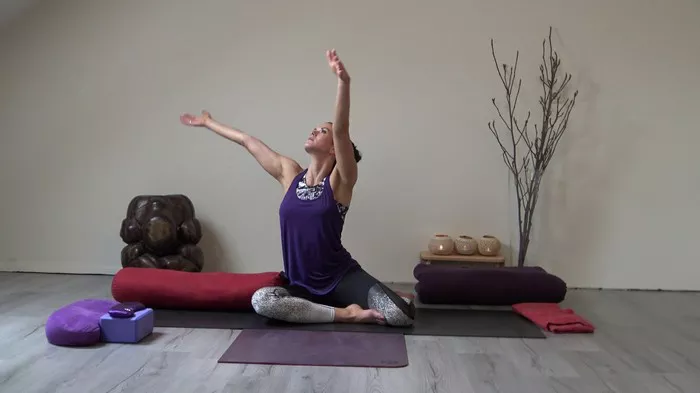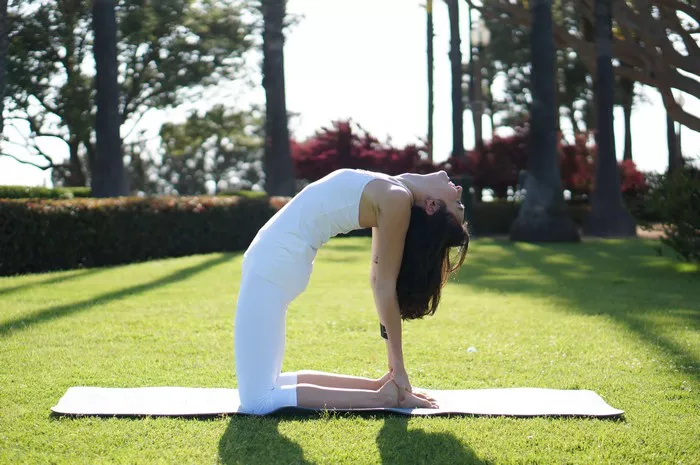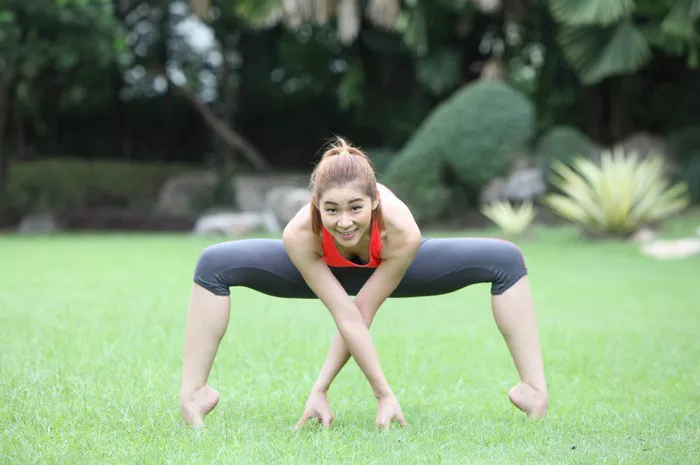In our fast-paced world, getting a good night’s sleep can often feel elusive. Stress, anxiety, and even poor sleep habits can prevent many of us from getting the restful sleep we need. But what if there was a simple way to help ease your mind and body into a deeper, more restorative sleep? Yoga, with its calming and restorative practices, could be the solution. Even better, there are specific yoga poses you can do right in your bed to prepare for a peaceful night’s rest.
Yoga helps promote relaxation, reduce stress, and activate the parasympathetic nervous system (the “rest and digest” system), which is key for preparing the body for sleep. In this article, we will explore several gentle, bed-friendly yoga poses that can help relax your body and mind, ultimately enhancing your sleep quality.
Why Yoga Helps You Sleep
Yoga is known for its ability to calm both the mind and body. Through focused breathing, gentle movements, and mindful relaxation, yoga can lower cortisol levels (the stress hormone) and activate the relaxation response in the body. This helps reduce muscle tension, release built-up stress, and promote a sense of overall well-being.
When done before bed, certain yoga poses can:
Activate the parasympathetic nervous system – Yoga calms the nervous system, which can make it easier for your body to transition into sleep mode.
Release physical tension – Gentle stretches can loosen tight muscles, especially those that may have built up tension throughout the day.
Quiet the mind – Meditation and mindful breathing can clear mental clutter, making it easier to drift off to sleep.
Regulate the breath – Deep, controlled breathing activates relaxation, helping slow the heart rate and calm the mind.
With these benefits in mind, let’s take a look at some simple and effective yoga poses you can practice right in the comfort of your own bed.
1. Child’s Pose (Balasana)
Child’s Pose is a grounding pose that helps calm the mind and relieve tension in the back, shoulders, and neck. It is an excellent starting pose for your bedtime yoga practice.
How to Do Child’s Pose in Bed:
Start by kneeling on your bed with your knees spread apart, keeping your feet together.
Sit back on your heels, and then slowly lower your chest to the bed, extending your arms forward on the mattress.
Rest your forehead gently on the bed, and focus on your breath.
Stay here for 1-3 minutes, breathing deeply, and allow your body to relax.
Benefits:
- Relieves tension in the lower back.
- Stretches the hips, thighs, and ankles.
- Calms the nervous system, preparing the body for sleep.
2. Reclined Butterfly Pose (Supta Baddha Konasana)
Reclined Butterfly Pose opens up the hips and stretches the inner thighs while calming the body. This pose can be particularly beneficial for anyone who experiences tension or discomfort in the lower body.
How to Do Reclined Butterfly Pose in Bed:
Lie on your back with your knees bent and feet flat on the bed.
Bring the soles of your feet together, letting your knees fall out to the sides, creating a butterfly shape with your legs.
Rest your hands on your belly or by your sides.
Close your eyes and take slow, deep breaths, staying in the pose for 3-5 minutes.
Benefits:
- Opens the hips and groin area.
- Releases tension in the lower back and pelvis.
- Stimulates relaxation and reduces anxiety.
3. Legs Up the Wall (Viparita Karani) – Modified for Bed
This pose is fantastic for relieving stress and anxiety. It helps drain excess fluid from the legs and encourages relaxation by stimulating the parasympathetic nervous system.
How to Do Legs Up the Wall in Bed:
Lie on your back with your legs extended in front of you.
Lift your legs up onto the headboard or the wall, if you have space in your bed.
If you’re using a headboard, your legs should be at a 90-degree angle to your body.
Let your arms rest by your sides, palms facing up.
Breathe deeply and stay in the pose for 5-10 minutes.
Benefits:
- Relieves tension in the legs and lower back.
- Reduces fatigue and encourages relaxation.
- Helps calm the nervous system, promoting a sense of peace before sleep.
4. Seated Forward Fold (Paschimottanasana)
The Seated Forward Fold stretches the spine, hamstrings, and lower back while calming the mind. This gentle stretch can release the tension built up throughout the day and improve your flexibility.
How to Do Seated Forward Fold in Bed:
Sit on the edge of your bed with your legs extended straight in front of you.
Inhale deeply, lengthen your spine, and as you exhale, gently fold forward from your hips, reaching your hands toward your feet or shins.
Let your head and neck relax, and breathe deeply as you hold the pose for 2-3 minutes.
You can also bend your knees slightly if needed, to make the stretch more comfortable.
Benefits:
- Relieves tension in the lower back and hamstrings.
- Helps calm the mind and reduces mental clutter.
- Lengthens the spine, releasing pressure from sitting or standing all day.
5. Cat-Cow Pose (Marjaryasana-Bitilasana) – Modified for Bed
This dynamic pose flows between arching and rounding your spine. While traditionally done on all fours, a modified version can be done lying on your back, making it perfect for bed.
How to Do Modified Cat-Cow in Bed:
Lie on your back with your knees bent and feet flat on the bed.
Place your hands on your abdomen or the sides of your body.
Inhale deeply and arch your back, pushing your belly button toward the ceiling (this is the Cow position).
Exhale and round your back, pulling your belly button toward your spine (this is the Cat position).
Repeat this movement slowly and mindfully for 1-2 minutes.
Benefits:
- Improves spinal mobility and flexibility.
- Relieves tension in the back and shoulders.
- Stimulates circulation and helps relax the body for sleep.
6. Supine Twist (Supta Matsyendrasana)
The Supine Twist is a gentle way to release tension from the spine, lower back, and shoulders. It also aids digestion, which can be helpful if you’ve eaten a heavy meal before bed.
How to Do Supine Twist in Bed:
Lie on your back with your knees bent and feet flat on the bed.
Extend your arms out to the sides, forming a T-shape with your body.
As you inhale, drop both knees to one side, keeping your shoulders grounded on the bed.
Hold the twist for 1-2 minutes, then gently return to center and repeat on the other side.
Focus on your breath and let go of any tension with each exhale.
Benefits:
- Releases tension in the spine and hips.
- Improves spinal flexibility.
- Aids digestion and promotes relaxation.
7. Savasana (Corpse Pose)
Savasana is a deeply relaxing pose typically practiced at the end of a yoga session. It helps quiet the mind and allows the body to fully absorb the benefits of the practice. It’s the perfect pose to do before sleep, as it encourages total relaxation.
How to Do Savasana in Bed:
Lie flat on your back with your legs extended and arms at your sides, palms facing upward.
Close your eyes and take deep, calming breaths.
Allow your body to relax completely, focusing on releasing any remaining tension in your body.
Stay in this position for 5-10 minutes, or as long as you feel necessary to fully unwind.
Benefits:
- Calms the nervous system and promotes deep relaxation.
- Helps release any lingering stress or anxiety.
- Prepares the body and mind for sleep.
8. Breathing Exercises (Pranayama)
In addition to physical poses, yoga’s breathing techniques (pranayama) can be incredibly effective in calming the mind before bed. By focusing on deep, slow breaths, you activate the parasympathetic nervous system, helping you relax and prepare for sleep.
How to Do Simple Breathing Exercises in Bed:
Lie in a comfortable position on your back in bed.
Begin by taking deep, slow breaths through your nose. Count to four as you inhale.
Hold your breath for a count of four.
Exhale slowly through your mouth for a count of six.
Repeat this breathing cycle for 5-10 minutes, focusing on slow, deep breaths.
Benefits:
- Calms the mind and reduces anxiety.
- Activates the parasympathetic nervous system.
- Improves oxygen flow to the body, helping with relaxation.
See Also: What Are the Different Types of Yoga Poses?
Conclusion
Incorporating a few gentle yoga poses into your bedtime routine can be a powerful tool for improving sleep quality. Whether you’re looking to release physical tension, calm your racing thoughts, or prepare your body for a restful night, yoga offers a natural and effective solution.
The poses outlined in this article are simple and easy to perform right in your bed, making it accessible to anyone, regardless of experience level. By regularly practicing these bed-friendly yoga poses, you can enhance your overall well-being, reduce stress, and enjoy a deeper, more restorative sleep.
So, the next time you’re struggling to wind down for the night, remember that a few minutes of gentle yoga might be just the remedy you need for a peaceful slumber.
You Might Be Interested In:




















